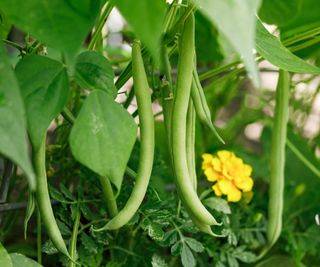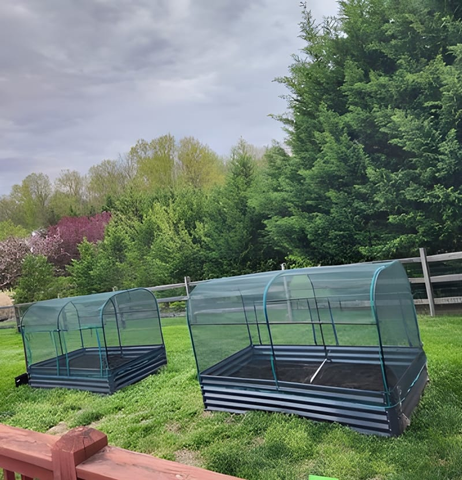The Growing Importance of Greenhouse Technologies
In an era of increasing environmental challenges and food security concerns, greenhouse technologies are emerging as crucial tools for sustainable agriculture. These technologies offer a controlled environment for crop production, allowing growers to optimize conditions and maximize yields while minimizing resource consumption and environmental impact.
Pushing Boundaries for Sustainable Agriculture
As the global population continues to rise, the demand for food grows exponentially. Greenhouse technologies push the boundaries of traditional agriculture by offering innovative solutions to address challenges such as climate change, water scarcity, and land degradation. By harnessing the power of technology, we can cultivate a more resilient and sustainable food system for future generations.

Advanced Climate Control Systems
Automated Ventilation and Cooling
State-of-the-art greenhouse systems utilize automated ventilation and cooling mechanisms to maintain optimal temperature and airflow levels. This ensures that crops remain comfortable and thrive in a controlled environment, even during extreme weather conditions.
Humidity Regulation Technologies
Advanced humidity regulation technologies help balance moisture levels within the greenhouse, preventing issues such as mold growth and plant stress. Humidity sensors and automated misting systems work together to create a favorable microclimate for crop growth.
Precision Heating Solutions
Precision heating solutions, such as radiant heating systems and geothermal heat pumps, provide uniform warmth throughout the greenhouse without relying on fossil fuels. This energy-efficient approach reduces heating costs and minimizes carbon emissions, contributing to a greener future.
Integration of Artificial Intelligence
The integration of artificial intelligence (AI) into greenhouse climate control systems enables real-time monitoring and adaptive responses to environmental changes. AI algorithms analyze data from sensors and weather forecasts to optimize conditions for plant growth, enhancing productivity and resource efficiency.
Water Management Innovations
Automated Irrigation Systems
Automated irrigation systems deliver precise amounts of water directly to the root zone of plants, minimizing wastage and optimizing moisture levels. Drip irrigation, micro-sprinklers, and fogging systems are among the innovative solutions used to conserve water in greenhouse operations.
Hydroponic and Aeroponic Techniques
Hydroponic and aeroponic growing techniques eliminate the need for soil, allowing plants to grow in nutrient-rich water solutions or suspended in air. These soilless systems promote water efficiency and nutrient uptake, resulting in faster growth and higher yields.
Water Recycling and Filtration Systems
Water recycling and filtration systems capture and treat runoff and condensation from greenhouse operations, reducing water usage and preventing contamination of natural water sources. Advanced filtration technologies remove impurities and pathogens, ensuring a safe and sustainable water supply for irrigation.
Sensor-Based Monitoring for Optimal Water Usage
Sensor-based monitoring systems track soil moisture levels, humidity, and plant transpiration rates to optimize water usage in the greenhouse. By providing real-time data and insights, these systems enable growers to make informed decisions and conserve water without compromising crop quality or yield.
Energy-Efficient Lighting Solutions
LED Grow Lights
LED grow lights are revolutionizing indoor farming by providing customizable spectrum and intensity options tailored to specific crop needs. These energy-efficient lighting solutions mimic natural sunlight and promote photosynthesis, resulting in healthier plants and higher yields.
Solar-Powered Lighting Systems
Solar-powered lighting systems harness renewable energy from the sun to illuminate greenhouses during periods of low natural light. Photovoltaic panels capture solar energy, which is stored in batteries and used to power LED grow lights, reducing reliance on grid electricity and lowering operating costs.
Spectrum Control for Plant Growth Optimization
Spectrum control technology allows growers to adjust the light spectrum emitted by LED grow lights to optimize plant growth at different stages of development. By fine-tuning light wavelengths, growers can enhance photosynthesis, flowering, and fruiting processes, resulting in higher-quality crops.
Smart Lighting Management
Smart lighting management systems integrate sensors and algorithms to regulate lighting schedules based on plant requirements and environmental conditions. These systems ensure efficient use of energy while maximizing plant growth and productivity, contributing to sustainable greenhouse operations.
Next-Generation Growing Mediums
Soilless Growing Mediums
Soilless growing mediums, such as coco coir, perlite, and rock wool, offer a clean and sterile environment for plant roots to thrive. These lightweight and porous materials provide excellent aeration and drainage, promoting healthy root development and nutrient uptake.
Biodegradable Substrates
Biodegradable substrates made from renewable materials, such as bio-based plastics and agricultural residues, are gaining popularity as sustainable alternatives to traditional growing mediums. These substrates break down naturally over time, reducing waste and environmental impact.
Recycled and Sustainable Materials
Recycled and sustainable materials, such as composted organic matter and recycled plastics, are being used to create innovative growing mediums for greenhouse agriculture. These eco-friendly alternatives minimize resource depletion and contribute to circular economy practices.
Incorporation of Microorganisms for Soil Health
The incorporation of beneficial microorganisms, such as mycorrhizal fungi and rhizobacteria, into growing mediums, enhances soil health and nutrient cycling in greenhouse operations. These microbial allies form symbiotic relationships with plant roots, improving nutrient uptake and disease resistance.

Vertical Farming Systems
Tower Gardens
Tower gardens utilize vertical space efficiently by stacking growing trays or towers on top of each other. These space-saving systems are ideal for urban environments where land is limited, allowing growers to maximize crop production in a small footprint.
Hydroponic Vertical Farms
Hydroponic vertical farms use nutrient-rich water solutions to grow plants in stacked layers or vertical columns. This soilless growing technique eliminates the need for soil and conserves water, making it an efficient and sustainable option for greenhouse agriculture.
Aeroponic Vertical Farms
Aeroponic vertical farms suspend plant roots in the air and mist them with nutrient-rich water solutions at regular intervals. This innovative growing method promotes rapid growth and high yields while conserving water and minimizing nutrient runoff.
Multi-Layered Growing Systems
Multi-layered growing systems combine hydroponic, aeroponic, and vertical farming techniques to maximize space utilization and crop diversity in greenhouses. These flexible systems allow growers to cultivate a wide range of plants year-round, from leafy greens to vine crops.
Robotics and Automation
Robotic Harvesting Technologies
Robotic harvesting technologies use computer vision and robotic arms to identify and pick ripe fruits and vegetables with precision and efficiency. These automated systems reduce labor costs and harvest time while minimizing damage to crops and increasing yield.
Automated Planting and Transplanting Systems
Automated planting and transplanting systems streamline the process of seeding and transplanting crops in the greenhouse. Robotic seeders and transplanters ensure uniform spacing and planting depth, resulting in healthier plants and higher yields.
Weeding and Pest Control Robots
Weeding and pest control robots use artificial intelligence and machine learning algorithms to identify and remove weeds and pests from greenhouse crops. These autonomous robots minimize the need for chemical pesticides and manual labor, promoting sustainable pest management practices.
Autonomous Greenhouse Management
Autonomous greenhouse management systems integrate sensors, actuators, and control algorithms to regulate environmental conditions and crop growth automatically. These smart-systems optimize resource usage, reduce energy costs, and increase productivity, allowing growers to focus on strategic decision-making.
Biological Pest and Disease Management
Biocontrol Agents
Biocontrol agents, such as predatory insects and beneficial nematodes, are used to control pests and diseases in greenhouse crops naturally. These biological control methods target specific pests while minimizing harm to beneficial insects and the environment.
Microbial Pesticides
Microbial pesticides, derived from naturally occurring microorganisms like bacteria and fungi, offer environmentally friendly alternatives to chemical pesticides. These bio-based pesticides target pests' specific vulnerabilities while posing minimal risk to human health and non-target organisms.
Genetically Modified Organisms for Pest Resistance
Genetically modified organisms (GMOs) engineered for pest resistance help protect greenhouse crops from damage by insect pests and diseases. These genetically enhanced plants produce natural toxins or repel pests through genetic modifications, reducing the need for chemical interventions.
Disease-Resistant Plant Varieties
Disease-resistant plant varieties bred through traditional or molecular breeding techniques offer enhanced protection against common greenhouse diseases. These resilient varieties exhibit natural resistance to pathogens, reducing crop losses and the reliance on fungicides.
Remote Monitoring and Control
Wireless Sensor Networks
Wireless sensor networks deployed throughout the greenhouse collect data on environmental conditions, crop health, and resource usage in real time. These sensor networks provide growers with valuable insights and alerts, enabling proactive decision-making and resource management.
Cloud-Based Data Analytics
Cloud-based data analytics platforms process and analyze large volumes of greenhouse data collected from sensors and IoT devices. These analytics platforms generate actionable insights and predictive models, helping growers optimize growing conditions and improve crop performance.
Remote Access and Control Platforms
Remote access and control platforms enable growers to monitor and adjust greenhouse operations from anywhere using mobile devices or computers. These remote management tools offer flexibility and convenience, allowing growers to respond promptly to changing conditions and emergencies.
Real-Time Monitoring of Environmental Conditions
Real-time monitoring systems track environmental conditions, such as temperature, humidity, and CO2 levels, inside the greenhouse. These systems provide growers with up-to-date information on growing conditions, allowing them to make timely adjustments and optimize plant growth.

Integration of Renewable Energy Sources
Solar Power Integration
Solar power integration involves harnessing energy from the sun using photovoltaic panels installed on greenhouse roofs or nearby solar arrays. Solar panels generate clean and renewable electricity to power greenhouse operations, reducing reliance on fossil fuels and lowering carbon emissions.
Wind Energy Solutions
Wind energy solutions utilize wind turbines or micro wind generators to convert wind energy into electricity for greenhouse use. Wind turbines can be integrated into greenhouse structures or installed in nearby locations with high wind exposure, providing a reliable source of renewable energy.
Geothermal Heating and Cooling
Geothermal heating and cooling systems utilize the natural heat stored in the earth's crust to regulate temperatures inside the greenhouse. Geothermal heat pumps extract heat from the ground in winter and transfer excess heat back into the ground in summer, maintaining a comfortable climate year-round.
Energy Storage Systems
Energy storage systems, such as batteries or thermal storage tanks, store excess energy generated from renewable sources for later use in the greenhouse. These storage systems ensure a reliable and uninterrupted power supply, even during periods of low renewable energy production.
Innovative greenhouse technologies hold tremendous potential to revolutionize agriculture and address pressing global challenges such as food security, climate change, and resource scarcity. By harnessing the power of technology, we can create a more resilient, sustainable, and equitable food system for the future.
As stewards of the land and guardians of our food supply, we have a responsibility to embrace sustainable agriculture practices and support the adoption of innovative greenhouse technologies. By working together to overcome challenges, drive innovation, and promote ethical and environmentally conscious farming practices, we can create a brighter and more prosperous future for all.









